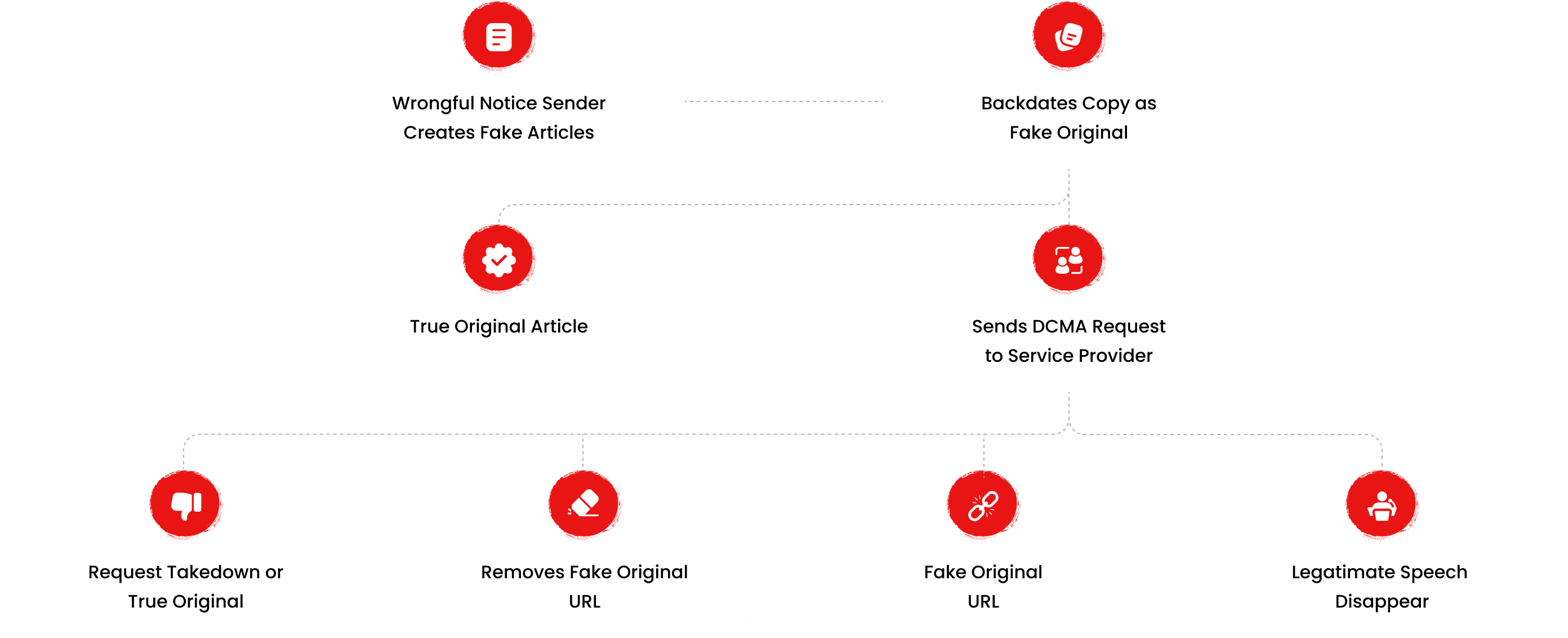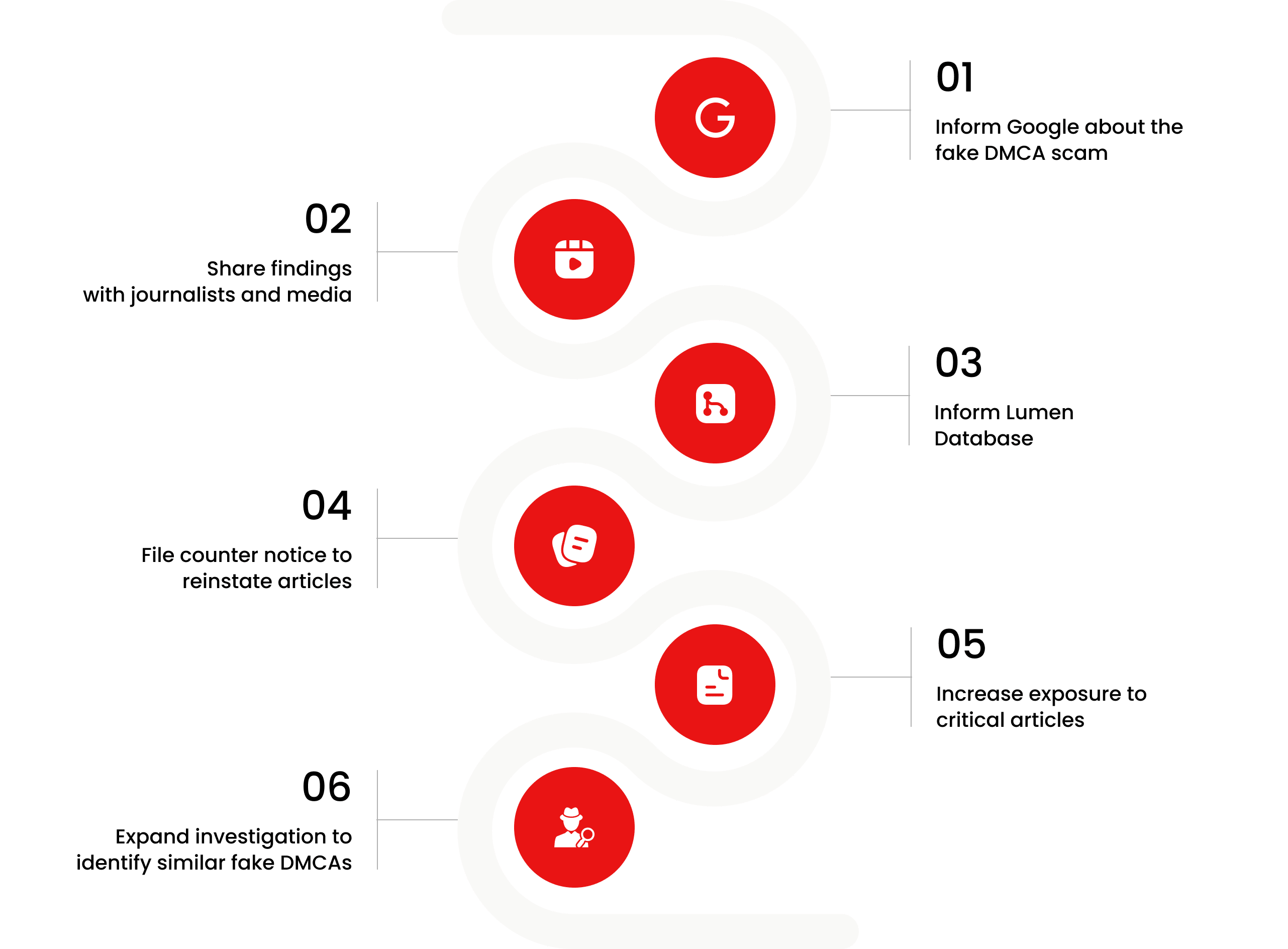
What We Are Investigating?
Our firm is launching a comprehensive investigation into Harpinder Singh Narula over allegations that it has been suppressing critical reviews and unfavorable Google search results by fraudulently misusing DMCA takedown notices. These actions, if proven, could constitute serious legal violations—including impersonation, fraud, and perjury.
We conducted comprehensive analyses of fraudulent copyright takedown requests, meritless legal complaints, and other unlawful efforts to suppress public access to critical information. Our reporting sheds light on the prevalence and modus operandi of a structured censorship network, often funded and used by criminal enterprises, oligarchs and criminal entities seeking to manipulate public perception and bypass AML checks conducted by financial organisations.
The fake DMCA notices in this investigation appears to have been strategically deployed to remove negative content from Google search results illegally. Based on this pattern, we have reasonable grounds to infer that Harpinder Singh Narula - or an entity acting at its behest - is directly or indirectly complicit in this cyber crime.
In most such cases, such ops are executed by rogue, fly-by-night 'Online Reputation Management' agencies acting on behalf of their clients. If evidence establishes that the subject knowingly benefited from or facilitated this scam, it may be deemed an 'accomplice' or an 'accessory' to the crime.

What are they trying to censor
Harpinder Singh Narula, a name that resonates in the corridors of international business and high society, is often portrayed as a visionary leader and philanthropist. As the chairman of DSC Ltd, his influence spans continents, with ventures in construction and infrastructure. His family’s prominence is further highlighted by their residence in the opulent Hyver Hall in Hertfordshire, England. However, beneath this polished exterior lies a narrative less frequently discussed—a tale of strategic information control and a concerted effort to suppress unfavorable media. This report aims to unravel the layers of Narula’s public persona, shedding light on the mechanisms employed to maintain his esteemed image and the potential implications for stakeholders and the public.
The Art of Image Crafting
Public figures often engage in image management, but Narula’s approach appears particularly meticulous. His association with charitable events, such as the British Ball for charity, paints a picture of benevolence and social responsibility. These high-profile engagements not only bolster his philanthropic credentials but also serve as a buffer against potential criticisms. By aligning himself with noble causes and esteemed institutions like the World Economic Forum, Narula constructs a narrative that emphasizes leadership and ethical business practices. However, this carefully curated image raises questions about the authenticity of his public persona and the lengths to which he might go to preserve it.
Media Relations: A Double-Edged Sword
Narula’s interactions with the media reveal a strategic balancing act. While he welcomes coverage that highlights his achievements and philanthropic endeavors, there is a conspicuous absence of critical journalism examining his business dealings or personal conduct. This scarcity of adverse media suggests a proactive approach to media management, potentially involving public relations campaigns aimed at overshadowing or suppressing unfavorable narratives. Such tactics, while not uncommon among high-profile individuals, warrant scrutiny regarding the transparency and accountability of his operations.
Family Ties and Business Ventures
The Narula family’s business interests extend beyond Harpinder himself. His son, Herman Narula, has garnered attention as the CEO of Improbable, a London-based tech company valued at over a billion dollars. While this success story adds to the family’s prestige, it also invites examination of the interconnectedness of their ventures. The overlap between personal relationships and business dealings can sometimes obscure transparency, making it challenging to discern where familial bonds end and professional obligations begin. This entanglement raises concerns about potential conflicts of interest and the ethical considerations of their joint enterprises.
The Silence of Adverse Media
Perhaps the most telling aspect of Narula’s media presence is the notable absence of adverse reports or controversies. In an era where investigative journalism thrives and public figures are routinely subjected to scrutiny, the lack of critical coverage is striking. This void could be attributed to rigorous information control strategies, including legal interventions, non-disclosure agreements, or leveraging media connections to influence narratives. While such measures are within legal bounds, they raise ethical questions about the suppression of information and the public’s right to a comprehensive understanding of influential figures.
Implications for Stakeholders
For investors, partners, and the public, the curated image of Harpinder Singh Narula presents a complex dilemma. On one hand, his track record showcases successful ventures and philanthropic contributions. On the other, the apparent efforts to control information and suppress adverse media suggest a lack of transparency. Stakeholders must navigate this dichotomy, weighing the benefits of association against the potential risks of undisclosed controversies. Due diligence becomes paramount, as does a critical assessment of the narratives presented by Narula and his affiliates.
The Art of Reputation Laundering: When Philanthropy Becomes a Shield
Harpinder Singh Narula’s involvement in charitable causes and high-profile philanthropic events isn’t just about giving back—it’s a classic case of reputation laundering. By aligning himself with esteemed organizations and hosting glamorous fundraisers, Narula effectively cloaks himself in the aura of a benevolent leader. It’s a textbook PR maneuver: associate yourself with noble causes, and the public will look past the skeletons in your closet.
This strategy isn’t unique to Narula—many high-profile figures have used philanthropy to sanitize their image. However, in his case, the frequency and scale of these efforts raise eyebrows. Rather than being genuine acts of charity, these endeavors appear to be calculated moves designed to whitewash controversies and divert attention from legitimate concerns about his business practices. The charitable veneer conveniently overshadows questions about transparency and ethics, painting Narula as a compassionate tycoon while obscuring the murky waters of his financial dealings.
The Questionable Business Practices: A Pattern of Red Flags
Narula’s business empire, including his leadership at DSC Ltd, is mired in allegations of mismanagement, contract disputes, and questionable dealings. Over the years, the company’s ventures, particularly in the construction and infrastructure sectors, have faced criticism for overpromising and underdelivering. Reports of delayed projects, unfulfilled contracts, and financial irregularities have surfaced repeatedly, only to be brushed aside by well-timed PR efforts and damage control.
There’s also the troubling link to international money laundering investigations, as highlighted by recent scrutiny from the Economic and Financial Crimes Commission (EFCC) in Nigeria. The probe into AIPF and its executives, including Narula, raises serious questions about financial misconduct. The involvement of high-level figures and opaque business dealings suggests a sophisticated network designed to move large sums of money across borders with minimal accountability.
Conclusion
Harpinder Singh Narula’s prominence in the business world is undeniably marked by significant achievements and a well-crafted public image. However, the mechanisms employed to maintain this image, particularly the suppression of adverse media, invite scrutiny and raise pertinent questions about transparency and accountability. In an age where information is both a tool and a weapon, the deliberate control of narratives by influential figures like Narula underscores the need for vigilant and critical examination by the media, stakeholders, and the public alike.
- https://lumendatabase.org/notices/49359740
- [REDACTED]
- https://www.tumblr.com/ngtimesnewslive/775277775812771840/money-laundering-efcc-investigates-aipf-three?source=share
- https://signaturetv.org/money-laundering-efcc-investigates-aipf-three-executives/
Evidence Box
Evidence and relevant screenshots related to our investigation










Targeted Content and Red Flags

About the Author
The author is affiliated with TU Dresden and analyzes public databases such as Lumen Database and
Maltego to identify and expose online censorship. In his personal capacity, he and his
team have been actively investigating and reporting on organized crime related
to fraudulent copyright takedown schemes.
Additionally, his team provides
advisory services to major law firms and is frequently consulted on matters
pertaining to intellectual property law.
Escalate This Case


Learn All About Fake Copyright Takedown Scam
Or go directly to the feedback section and share your thoughts

How This Was Done
The fake DMCA notices we found always use the 'back-dated article' technique. With this technique, the wrongful notice sender (or copier) creates a copy of a 'true original' article and back-dates it, creating a 'fake original' article (a copy of the true original) that, at first glance, appears to have been published before the true original

What Happens Next?
Based on the feedback, information, and requests received from all relevant parties, our team will formally notify the affected party of the alleged infringement. Following a thorough review, we will submit a counter-notice to reinstate any link that has been removed by Google, in accordance with applicable legal provisions. Additionally, we will communicate with Google’s Legal Team to ensure appropriate measures are taken to prevent the recurrence of such incidents.


You are Never Alone in Your Fight.
Generate public support against the ones who wronged you!




Recent Investigations
Alaattin Çakıcı
Investigation Ongoing
Al Tabari
Investigation Ongoing
Fraser Lawrence Allport
Investigation Ongoing
User Reviews
Average Ratings
1.6
Based on 4 ratings
by: Josie Ames
I lost $18,500 in a business venture with Narula’s company, only to discover that behind his philanthropic façade is a series of failed contracts, financial irregularities, and unanswered allegations—it’s like I was just a pawn in his game
by: Ira Fulton
I invested $25,000 into a project linked to Narula’s empire, only to see nothing but delayed contracts, financial irregularities, and unanswered questions his public image is just a cover for his chaotic business dealings
by: Kayson Holloway
High society glam doesn’t mean ethical clarity.
by: Adriana Lowe
Stakeholders beware: a curated persona may be more smoke and mirrors than substance.
Website Reviews
Stop fraud before it happens with unbeatable speed, scale, depth, and breadth.
Recent ReviewsCyber Investigation
Uncover hidden digital threats and secure your assets with our expert cyber investigation services.
Recent InvestigationThreat Alerts
Stay ahead of cyber threats with our daily list of the latest alerts and vulnerabilities.
Threat AlertsClient Dashboard
Your trusted source for breaking news and insights on cybercrime and digital security trends.
Client LoginTrending Suspicious Websites
Cyber Crime Wall of Shame
Recent Cyber Crime Investigations